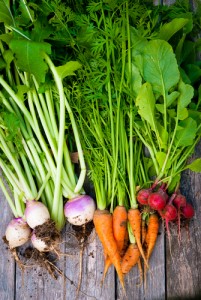- Home
- About Us
- Contact Us
- Your Gift Card: Activate
- Check Card Balance
- Your Shopping Cart
 Did you know that in Australia we waste about 30% of the food we purchase? That's a lot of money that is going into the bin – and straight into landfill. On a bigger scale, across the globe we end up throwing away around a third of our food.
Did you know that in Australia we waste about 30% of the food we purchase? That's a lot of money that is going into the bin – and straight into landfill. On a bigger scale, across the globe we end up throwing away around a third of our food.
When we think about the above statistics it's clear that food wastage is a social, environmental and economic issue for us all. Yet a recent movement aimed at minimising food waste is taking root to change all that. From world renown chefs to the everyday home cook, we can all look for ways to make our cooking habits more sustainable.
Stem to root
Eco chef Tom Hunt, of Bristol's Poco restaurant explained that stem to root cooking is about making use of the whole plant. "It's about cooking consciously in our own kitchens. This way, everyone can help prevent food waste, rather than contribute to it," he said.
That means no more throwing away your potato skins – cook with them on or keep them to fry up later. If this is news to you then you'll probably be surprised at the ways you can use your scraps! Here are some more:
Hunt makes sure that all his recipes use whole ingredients, so there's never a dish that only requires half a vegetable. He's so passionate about minimising food wastage that he set up the Forgotten Feast, a roaming restaurant that takes food that would otherwise go to landfill and makes it into delicious dishes. He's also works for a multitude of food charities.
Thankfully, Hunt isn't the only chef getting inventive with his fruit and vegetable offcuts. Andrea Reusing of the North Carolina restaurant Lantern creates original recipes such as toasted watermelon seeds in panna cotta, while Milan's Alice Delcourt makes use of vegetable scraps and day-old bread for soup and stew bases. She even uses the restaurant's leftover water on the garden!
Tip to tail
Of course reducing waste doesn't just extend to just fruit and vegetables. There's a lot of meat offcuts that we simply throw away when they are perfectly suitable for inventive and delicious dishes.
Paul Cooper, who is head chef at Sydney restaurant Bishop Sessa, is a staunch believer in using all of the animal because it's important to give every part the respect it deserves. During his chef training Cooper made sure he learned about the cuts of meat we rarely see and how he could make the most of these parts. For those of us at home, he recommended choosing pork shoulder from the butcher. Because it's a cut not many know how to cook with it's a cost effective choice, and just needs to be slow cooked all day for a great meal.
Across the world, chefs are embracing the tip to tail ethos. For example, the two Michelin-starred Italian restaurant Torre del Saracino uses dried fish scales to flavour its table salt and Julien Fouin of the Paris restaurants Marais is well known for using all parts of animals, from brains to tails and tongues in interesting combinations – think ox tongue with herbs and vegetables or even chocolate and coffee cream with liver. Other famous chefs embracing the tip to tail food movement include London's Fergus Henderson of the restaurant Saint John and San Francisco's Chris Cosentino of Incanto. These culinary masters are not alone, as many celebrity chefs carry the waste-not want-not flag into their restaurants, cookbooks and food columns.
Keeping, storing, and buying sustainably
Apart from using as much of our produce as we can when we cook, there are many other ways to eat sustainably and reduce wastage. Try out these tips when it comes to your own cooking:
While having a positive impact on both the environment and your wallet, taking a sustainable approach to food teaches you how to appreciate produce in a more holistic way. You can easily make some of these changes in your own home cooking, and be supporting the chefs trying to influence the culinary industry's attitude to waste. Why not check out how Paul Cooper inventively makes the most of ingredients by transforming them into dishes full of flavour? Bishop Sessa is a participating restaurant in the Good Food Gift Card program.